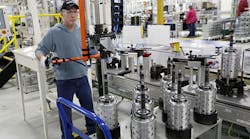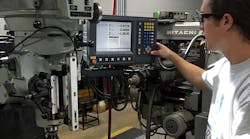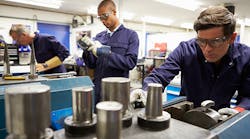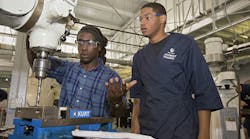The viability and vitality of U.S. manufacturing has been restored, according to the current economic and political trends, but in fact that restoration process has been in progress for several years, with trends like “reshoring” as well as capital investments in new production capabilities, the embrace of “smart” technologies, and in manufacturers’ adoption of new information standards and data communication capabilities.
Even more important, the condition of U.S. manufacturing has been under examination for decades. Against the obvious and impressive expansion of manufacturing economies elsewhere in the world, U.S. manufacturers have had to adapt to evolving standards for product quality and customer satisfaction, in order to remain globally competitive. And, regardless of the recent good news on this front, the standards for U.S. manufacturers to maintain their global competitiveness continue to evolve.
In 1965, manufacturing in the United States accounted for 53% of the economy. For over half a century, American manufacturing dominated the globe. However by 1988, manufacturing only made up 39% of the American economy, today only 9%. What happened? How can the United States ever be a manufacturing center again?
Globalization, outsourcing, and skills — The main causes of manufacturing losses were globalization, outsourcing — and a growing skills gap. The elimination of trade barriers created access to foreign markets for American manufacturers. Some businesses in the United States discovered that it was cheaper to outsource their production activities to countries overseas. In countries like China, people were willing to work around the clock for significantly less per hour than American workers.
Outsourcing manufacturing has cost Americans millions of jobs. However, this is changing. With rising costs for labor overseas and development of new technologies, many American manufacturing companies are revising their business strategies and bringing work (and jobs) back to their U.S. operations.
In order to make the most of this shift, it is essential now for these manufacturers to ensure that their American employees are highly skilled and up-to-date with the latest technology and tools.
Rising labor costs in foreign nations is one reason that manufacturers will return work back to the United States. In the early 1990s, labor was extremely cheap in Asia. Then, as the standards of living increased, labor costs also rose. China alone saw a 10% increase in labor costs, and that number is predicted to continue rising. Add in the costs for shipping and handling and it puts many businesses at an offshore disadvantage.
By reshoring their manufacturing operations, production and delivery costs will decrease, allowing manufacturers to produce more. This, combined with increased quality assurance and communication, is helping manufacturing in the United States to become increasingly competitive. But, it underscores the need to make manufacturing labor costs effective.
Rising Costs and New Technology
With advanced automation technologies and robotics, labor costs can be made more tolerable to manufacturers, reducing their incentive to send manufacturing work overseas. Manufacturers can find significant cost savings by investing technology. Some machines can increase productivity by as much as 70% via automation, while only costing as much as a single employee’s salary for one year.
In addition, with cloud computing and Internet of Things (IoT), digital sensors and chips can be programmed to feed information about a product’s performance to the manufacturer in real time. Placing sensors inside machines will alert them to processing errors, when parts are wearing out, ways to cut costs, and techniques to improve overall efficiency and design.
New technologies increase productivity to the extent that labor costs will not be as significant as the ability to effectively utilize advanced tools. U.S. manufacturing wages are still high by global standards, but investing in education and improving skills will add a new dimension to domestic manufacturers’ advantages: innovation.
To be innovative, U.S. manufacturers must have the intellectual resources available from technicians, engineers, and designers in their employment, improving and optimizing their operations and implementing new ideas for competing with manufacturers around the world. Transforming the U.S. into an “innovator economy” will be the future for American manufacturing. To achieve that, they must overcome the gap between the skills their employees have now – and the skills they need now, or will need soon.
Innovation is the future — What causes the skills gap? Experienced industrial workers are beginning to retire and some college-bound youth are not choosing to pursue careers in manufacturing. Some employers have stated that many of the students who present themselves as candidates for open positions come out of school with little hands-on experience, only theory.
This lack of real-world aptitude can cause them to approach problems without insight, or to design products that aren’t manufacturable, which leads to delays, scrap, and products failing in the field.
By standardizing training and design practices, the members of your team will become more productive. Properly trained workers are free to think creatively and to innovate, rather of searching the web for an answer or vainly seeking the advice of a help desk or call center.
Manufacturing companies today have access to resources that once were available only to large organizations and government agencies. Makerspaces, cloud / subscription-based software tools, and crowdfunding have given small businesses and startups the opportunity to innovate and disrupt various industries, but the challenge is bringing the right talent together, and putting an emphasis on ongoing learning and continuous improvement.
This is not a new recent development; it is a rapidly maturing factor in manufacturing. President Obama addressed it in 2014, saying:
“Part of what’s exciting is that, traditionally ... manufacturing meant big factories, all kinds of smoke and fire, and a lot of heavy capital. But because of advances in technology, part of the opportunity is now to make the tools that are needed for production and prototypes are now democratized. They’re in the hands of anybody who’s got a good idea.”
The manufacturing industry is evolving and growing at the same time. Over the next decade, nearly 3.5 million manufacturing jobs are expected to be available. Ongoing learning, training, and professional development will be necessary for manufactures to stay up-to-date with the latest techniques and processes. U.S. manufacturing is changing, and U.S. manufacturers must understand the changes in order to be prepared for the opportunities.











